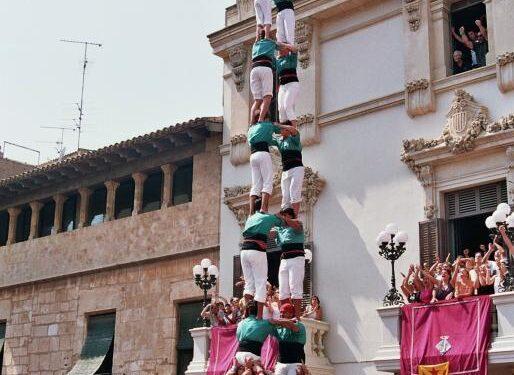Contents
Questo articolo è disponibile anche in:
Human pyramids more than 6 floors high rise to the sound of music in Catalonia: it is the cultural phenomenon of Castells.
Every year, Spain delights the public with amazing shows that consist in the raising of incredibly high towers. What is it about? These towers are not made of bricks, but of real people!
This popular tradition known as “Castells”, from the Catalan word “castles” referring to the remarkable height these “human buildings” can reach, entered the list of Intangible Cultural Heritage of UNESCO in 2010.
Towering human pyramids
Castells belong to a centuries-old tradition. Born between the 18th and 19th centuries near Tarragona, this tradition gradually spread to the rest Catalonia, thanks to its success among the population.
These human castles have a complex structure: they are supported at the base by numerous men on whom the floors of the structure are built, up to the top where trained children climb like agile monkeys. The “bricks” of these towers are the so-called “castellers”, people both trained to resist tough physical efforts and, most importantly, aware of the techniques to “assemble” the Castells. It takes months to be properly trained before the public performance.
Castells can reach between 6 and 10 floors in height and usually stand in front of municipal buildings. Further, the whole performance is accompanied by the sound of musical instruments. It is possible to hear, in fact, a traditional music called “gralla“, which takes on a calmer pace as the Castells are built, or a faster one as the reverse process of deconstruction starts. The types of instruments used are small drums and oboes.
Intangible Heritage of Unesco
On 16th November 2010 Castells were declared Intangible Cultural Heritage of Humanity by UNESCO. The committee underlined that they form part of the Catalan cultural identity and convey high values of solidarity and social cohesion.
Not surprisingly, castellers have a motto: “Força, Equilibri, Valor i Seny“, which means “strength, balance, value and common sense”. These four virtues, taken from the verse of a work by José Anselmo Clavé, refer to the qualities necessary for the construction of a Castell.
Castells: complex structures
Regarding the shape of the Castells, it should be noted that there exist several structural models, although they generally share a common “skeleton”.
The tower, made up of hundreds of people, has different layers. The first one is called pinya: it is the base that supports all the weight above. The upper layers can include the folre and the manilles, and on the latter stands a taller and slender layer called tronc; the top, finally, is called pom de dalt, and it is where the children climb.
Castellers belong to different social backgrounds, genders and ages. Those standing at the base of Castells must have greater strength and physical resistance, which is why they are almost always men (but there may also be women, in some cases). Female castellers generally appear on the upper floors, as they are lighter, up to the top where agile children become the protagonists.
Also interesting is the traditional uniform of castellers. It consists of a coloured shirt, white trousers, a protective band around the waist, and specific shoes called espardenya.
Sand castles?
Castells are very high “constructions”, as has been repeated, and potentially dangerous. Like sand castles, they can suddenly collapse. In other words, if one of its components falls, the entire structure suffers the consequences. This, of course, can lead to accidents of varying severity.
There have been three documented cases of fatal accidents: one in the 19th century, the second in 1983 and the last, the most recent, occurred in 2006. The third unfortunate accident involved a 12-year-old girl, who sustained a head injury falling from the pom de dalt.
In memory of that terrible loss, and since then, protective helmets have been imposed on all children, both during the training sessions and public performances.
Stay up to date by following us on Telegram!














